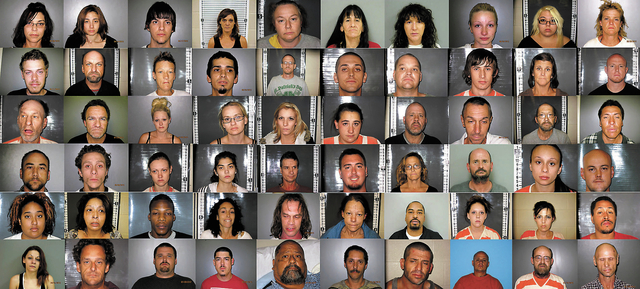JUST SAY DOPE!: Illegal drug use choking Pahrump justice system; costs taxpayers millions
“Nobody wakes up one day and says I’m going to be a drug addict or an alcoholic. It’s just something that happens; it’s a disease.”
Jake Wachtel, an alumnus of the Pahrump Drug Court, tells people this all the time when he’s sharing his own story of overcoming addiction.
Addiction is a powerful and life-altering force that can lead even those with the strongest resolve down a dark and life-changing path. It’s an issue that affects all types of people, from all walks of life, in communities of all sizes across the nation — Pahrump is not immune.
According to the National Institute on Drug Abuse, substance abuse costs the United States more than $193 billion a year in crime, lost work productivity and drug-related health care expenses combined.
The state of Nevada is no exception, boasting one of the highest percentages of people who admit to abusing drugs in the last year, an estimated 10 percent of the population in 2009, according to the most recent figures from the Office of National Drug Control Policy. The state ranked among the top 12 in the nation for the percentage of people who admitted drug use in the past month.
Stimulants, particularly methamphetamine, seem to be the drug of choice for Nevadans.
Just like in almost every corner of the state, Nye County’s courts and jails are full of drug addicts.
Drugs in Pahrump — Keeping it Rural
According to criminal complaints filed by the Nye County District Attorney’s office since January 2012, approximately one-third, about 31 percent, of all criminal cases filed by the local district attorney’s office were drug related.
Complaints collected by the Pahrump Valley Times show that approximately 756 of 2,404 cases filed by the district attorney’s office during that time contained charges related to the use, sale, possession, or trafficking of illegal substances.
Methamphetamine, prescription pills, marijuana and heroin are among the most common controlled substances Nye County Sheriff’s deputies see on the streets of this town.
According to NCSO arrest reports collected by the PVT, illegally held prescription pills were found in 141 arrests, meth in 149 arrests, heroin in 58 arrests, cocaine in nine arrests and marijuana in 140 arrests from January 2012 to Monday of this week. And those five substances together made up 91.5 percent of all illegal drugs found over the last two years.
“It’s a huge problem,” says Fifth Judicial District Court Judge Kimberly Wanker, who also oversees the Pahrump Drug Court. “We see methamphetamine, heroin, marijuana, cocaine…I was pumping gas the other day and I saw a drug deal go down. I’ve seen them go down in the parking lot at Walmart. I think it might be because I know what to look for, but it doesn’t take a rocket scientist to figure this out. If you read the police reports, which I get in the case files I read, where do these things occur? They take place at the gas station, they occur in the parking lots of fast food restaurants, in the parking lots of Smith’s and Albertson’s and about any place you go.
“It’s pretty bold the things they will do.”
Paul Rozario, assistant special agent in charge of the Las Vegas Drug Enforcement Administration field office, says meth, heroin and prescription pills have become a growing problem for communities all over the United States, especially in Southern Nevada over the last several years.
“Obviously methamphetamine is huge, more so than any other drug probably other than marijuana. Really, the two big problems we have are methamphetamine and the abuse of prescription medication. With the abuse of prescription drugs you’re talking about Oxycontin, Hydrocodone, drugs that are being diverted from legitimate medical use for addicts and people getting high off those drugs. And what happens is when people can’t afford to support those habits, the addict will then go toward heroin,” he said.
Rozario explained that part of the reason behind the increase in heroin use is it’s a cheaper version of the same high addicts can get with expensive prescription medications.
“When they can’t afford the cost of prescription medications on the black market, or if they can’t get those prescription medications from any sort of legitimate way, what they do, because the pills are much more expensive than say heroin, what they’ll end up doing is they’ll proceed to get that high somehow and move toward heroin,” the DEA agent said. “Because what Oxycotin or Hydrocodone is is basically a prescription opiate. So you’re trying to get the same effect at a cheaper price and that’s why they move toward heroin.”
Who is Affected?
Wachtel, a member of the local Drug Court Alumni Club, said he knows exactly what it feels like to be among those statistics.
He was addicted to meth for nearly 20 years before his last run-in with the law forced him to join the Drug Court here in Pahrump where he was finally able to get clean and sober.
“I used meth for about 20 years, every day. It was like my morning cup of coffee. I would get up in the morning, get shot up and then go to work. I didn’t think it was harmful; I mean I wasn’t out robbing anybody so what was the big deal? And that was all I knew. I didn’t think I would ever stop until I died,” he said.
Wachtel says although he didn’t recognize that he had a problem at the time, when he came before Judge Robert Lane, who helped launch Pahrump’s now-overflowing Drug Court, on a criminal matter several years ago, one that didn’t even involve the use of drugs, the judge placed him in the program.
“Judge Lane sentenced me to three years’ probation, a year suspended sentence and threw in a year of Drug Court and I wasn’t even on a drug charge,” he said. “Judge Lane obviously saw something that I didn’t notice. I didn’t think I looked all torn up or anything, and I was not happy. I was looking at my lawyer like what the heck? But I did it, I did it reluctantly.”
Although he wasn’t thrilled about being placed in Drug Court at first, Wachtel said it was one of the best things that has ever happened to him.
The program’s strict guidelines and structure for recovering addicts was able to help him not only stop using meth, but to do other things he hadn’t been able to accomplish while using drugs. Even simple chores such as getting his truck registered, getting his driver’s license back, all became miraculously easy tasks.
“It’s hard at first because you’re used to not doing anything, just doing your own thing and then all of the sudden someone’s telling you what you have to do, and you fight it, but that’s just that human nature I guess,” he said. “But my life is a lot better now. I’ve got a job, I just got a company credit card, I got my driver’s license and my truck registered and insured in my own name. I drove on a suspended driver’s license for 12 years and I finally got it back thanks to Drug Court.”
Although staying clean and sober two years out isn’t easy, Wachtel said he wouldn’t do anything to compromise the life he has now.
“I fight the urge to go get high every day still and I’ve been sober for over two years,” the recovering addict says. “Don’t get me wrong, when I was getting high I really loved it. I started slamming it and that feeling is great, but it only lasts for so long. The feeling I’ve got now will last for the rest of my life and that’s great … Just because you stop using dope doesn’t mean that your life is going to all of a sudden change and be Mary Poppins and all this other stuff, but you learn how to deal with life on life’s terms, that’s what I learned.”
While some may still say the only people drug abuse affects is the person subjecting themselves to those substances, local law enforcement officials feel otherwise.
District Attorney Brian Kunzi said in email response to questions for this story that “I have no hard numbers to show, but those of us in the law enforcement community believe most (criminal) cases have some connection to drug use.
“Many drug users fund their addiction by committing crimes like burglary and theft.”
Wanker agreed, adding, “The crime may not be a drug offense, but it is a product of the person being high on drugs. Home invasions, theft, burglary … Almost everyone will tell you that in the PSI, or pre-sentence investigation report, they’re interviewed, which is not open for the public to review, but they’ll say yes I was under the influence of this or this. It’s a huge problem.”
Daniel Cox, president of the local Drug Court Alumni Club, admitted he was one of those individuals who came to the Drug Court after addiction led to arrest several years ago.
“I asked the judge if I could be enrolled in Drug Court because I recognized that I had a drug problem. And I was facing a number of charges, not only drug charges but criminal charges, so I enrolled myself in the Drug Court,” he explained. “But now I’ll be off probation next month after three years.”
The Heart of the Matter
Sheriff Tony DeMeo says government needs to start looking at the root of the drug problem. In order to end the cycle of repeat offenses, the sheriff says, the root cause of a suspect’s reason for going out and committing crimes — their addiction — must be treated.
“You can’t arrest someone out of addiction,” the sheriff said during an interview earlier this year. “If you commit the crime, the crime is the crime you commit. But the thing is they’re dealing with social issues, like mental illness, drug addiction and so on and so forth. And outside of the crime, those are really medical problems, they’re all listed in the DMS3, or the DMS4 or DMS5 now, which is the psychiatric manual … Whenever we declare a war on something we haven’t been very successful with that. It’s just one of those things. I remember Lyndon B. Johnson declaring a war on poverty, there’s still poverty. (Richard) Nixon declared a war on drugs; we still have a drug problem.”
Although local organizations like the Drug Court and Westcare help people break the cycle of addiction, the problem persists.
Kunzi said one way to potentially lessen drug issues in the future is the continued prosecution of those supplying illegal substances to the community and to find ways to lessen the demand for the products in the first place.
“If we want to stop the merry-go-round, we need to reduce the demand our society has for illegal drugs. Unfortunately, the market system rules work for the drug culture as well as how they work for legitimate businesses. If there is no demand, there will be nothing for someone to sell,” he said. “I am a strong proponent of our Drug Court. We can reduce the amount of the property crimes that are being committed if we can successfully get the person to kick their addiction. Throwing drug users in jail does not address their addiction problems and, even if incarcerated, they return with the same addiction as before. The Drug Court model helps give the offender the motivation to clean up his or her life and leads to more successful behavior modification because we are directly addressing the addiction.”
Cox, Wachtel, Terry Leonard, treasurer of the local Drug Court Alumni Club, and David Huffines, also a member of the organization, share their experiences hoping to prevent others from traveling down the same path.
“Our biggest goal, what most of us got this started for, was actually to get a chance to go to the high school and talk to the teenagers about drugs and alcohol, because that for me is where I started was when I was a teen in high school,” Cox said. “We can relate to them. And I know there are a few out there right now, at this moment, who are probably loaded and that’s scary.”
“I was on parole at the time (I was enrolled in Drug Court) and I had given a dirty UA (urine test), so my parole officer made me sign up for Drug Court and it’s still working today. I’ve been off drugs for two years now and life is good today. And now I’m off parole,” Leonard added. “If we could get to just one person and change their life, we’re doing our job then.”
Although the group has only been together for about a year, they have already met with local organizations, like the NyE Communities Coalition, to talk with young adults and parents about the dangers of drug abuse and addiction.
“Fifteen years ago I lost my best friend to an overdose and I still used. I didn’t learn from it because, you know, it’s a disease,” Cox said. “I just want the community to know that we’re here and we’re trying to make a step toward something good, getting the word out about the use of drugs and alcohol.”
The Drug Court Alumni Club members said they hope soon to be able to conduct presentations at the local high school to get their message to the teenagers in the community as well.
They hope by talking to those who are now the same age they were when they began using, they can prevent them from becoming addicts.
“There’s free pamphlets (at the WestCare office) for parents and grandparents about different kinds of drugs and alcohol and what to look for, so they can always come here and get them and educate themselves,” Leonard added. “That’s what the alumni is about.”
For more information on the Drug Court Alumni Club or Westcare’s services, call 775-751-6990.

















